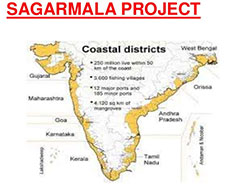Introduction
India’s maritime geography is a strategic asset—boasting a 7,500 km coastline and 14,500 km of navigable waterways. Yet, this potential has historically remained underleveraged. Recognizing this, the Government of India launched the Sagarmala Project in 2015, under the aegis of the Ministry of Ports, Shipping and Waterways (MoPSW). The project envisions holistic port-led development by integrating port infrastructure with industrial clusters, transport connectivity, and coastal community development.
Strategic Rationale
Despite its maritime advantage, India has faced persistent logistical inefficiencies, with costs accounting for nearly 13-14% of GDP—well above the global average. Fragmented infrastructure, congested ports, and limited coastal integration have hindered trade competitiveness. Sagarmala aims to rectify these challenges through a comprehensive infrastructure push—connecting ports with production and consumption centers via multimodal transport systems.
Vision and Pillars of Development
The central vision of the Sagarmala initiative is “Port-led prosperity through enhanced connectivity and infrastructure.” It is anchored on four key pillars:
- Port Modernization and Capacity Enhancement
- Modernize existing major and non-major ports.
- Establish new greenfield ports such as Vadhavan (Maharashtra) and Paradip Outer Harbour (Odisha).
- Leverage automation and smart logistics systems.
- Port-Linked Industrialization
- Develop Coastal Economic Zones (CEZs) and Port-Linked Industrial Clusters (PLICs) to boost manufacturing.
- Align with initiatives like Make in India and integrate with economic corridors such as the DMIC.
- Port Connectivity and Logistics Enhancement
- Strengthen hinterland connectivity through dedicated freight corridors, highways, and inland waterways.
- Promote multimodal logistics parks to enable seamless cargo movement.
- Coastal Community Development
- Enhance livelihoods through fisheries, maritime skill development, and eco-tourism.
- Focus on sustainable development in coastal districts.
Institutional Framework
The implementation of Sagarmala follows a decentralized, partnership-driven approach:
- Nodal Agency: Ministry of Ports, Shipping and Waterways
- Project Coordination: Sagarmala Development Company Ltd (SDCL)
- Execution Partners: State governments, port authorities, private sector entities
- Funding Model: Predominantly Public-Private Partnership (PPP) based, with viability gap funding where needed.
Project Status and Achievements (as of 2024)
- Projects Identified: Over 800 projects across port infrastructure, logistics, industrial clusters, and community development
- Total Estimated Investment: ₹5.5 lakh crore (~USD 66 billion)
- Projects Completed: Over 200 across key states such as Gujarat, Andhra Pradesh, Maharashtra, and Tamil Nadu
- Connectivity Milestones: Several major road and rail projects have enhanced last-mile connectivity to ports
Challenges in Execution
- Land Acquisition Hurdles: Delays in securing land rights have stalled several port and industrial projects.
- Environmental Compliance: Coastal projects face stringent ecological assessments, delaying approvals.
- Coordination Complexity: Overlap of responsibilities among central, state, and port agencies creates bureaucratic bottlenecks.
- Investment Risk Perception: Attracting private capital remains a challenge in regions with uncertain economic returns.
Emerging Opportunities
The success of Sagarmala is now increasingly tied to broader national strategies:
- Synergy with PM Gati Shakti: Integration with India’s multimodal infrastructure master plan improves planning and execution efficiency.
- Push for Green Ports and Blue Economy: Focus on clean energy, digitization, and sustainable maritime practices.
- Geo-economic Relevance: Enhanced connectivity with ASEAN, Africa, and Middle East trade routes positions India as a logistics hub in the Indo-Pacific.
Conclusion
The Sagarmala Project represents a transformative shift in India’s infrastructure strategy, moving from land-centric development to a maritime-led growth model. If implemented effectively, it can significantly reduce logistics costs, boost exports, create millions of jobs, and enhance coastal livelihoods. The coming years will be crucial in translating this ambitious vision into on-ground results—requiring robust governance, agile execution, and active private sector participation.
Frequently Asked Questions (FAQs) on the Sagarmala Project:
What is the Sagarmala Project?
The Sagarmala Project is a flagship initiative of the Government of India launched in 2015 to promote port-led development. It aims to modernize ports, improve logistics infrastructure, enhance connectivity, and develop coastal regions.
Who is implementing the Sagarmala Project?
The project is spearheaded by the Ministry of Ports, Shipping and Waterways (MoPSW), with coordination by the Sagarmala Development Company Ltd (SDCL). Implementation is carried out by various state governments, port trusts, and private sector entities.
What are the main objectives of the Sagarmala Project?
Modernize existing ports and develop new ones.
Enhance port connectivity via roads, railways, and inland waterways.
Develop Coastal Economic Zones (CEZs) and industrial clusters.
Improve the livelihoods of coastal communities through skill development and job creation.
How many projects are part of Sagarmala?
As of 2024, over 800 projects have been identified across various sectors including port modernization, connectivity enhancement, industrialization, and coastal development.
What is the total investment expected under the Sagarmala Project?
The total estimated investment is around ₹5.5 lakh crore (approximately USD 66 billion).
What are Coastal Economic Zones (CEZs)?
CEZs are large industrial clusters located near ports. They are designed to take advantage of port proximity to reduce transportation costs and boost export-oriented manufacturing.
Which new ports are being developed under Sagarmala?
Notable greenfield port projects include:
- Vadhavan Port (Maharashtra)
- Paradip Outer Harbour (Odisha)
- Others are under consideration based on strategic needs.
What is the role of the private sector in Sagarmala?
Private companies are crucial partners under the Public-Private Partnership (PPP) model. They participate in port construction, logistics infrastructure, and industrial clusters.
How does Sagarmala help reduce logistics costs?
By improving port efficiency, enhancing connectivity, and promoting coastal shipping, Sagarmala aims to reduce logistics costs from 13-14% of GDP to global benchmarks (around 8-10%).
How is the project aligned with other national initiatives?
Sagarmala complements several other national programs:
- PM Gati Shakti for multimodal logistics
- Make in India for industrial growth
- Blue Economy for sustainable ocean use
What benefits does the Sagarmala Project bring to coastal communities?
Employment through port and industrial activities
Skill development and training programs
Support for fisheries and eco-tourism
Infrastructure in coastal towns and villages



